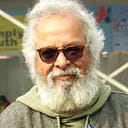Ami Ganatra, Mahabharat & saratis

Ami Ganatra. Alumni of Indian Institute of Management, Ahmedabad. She recently wrote Mahabharat Unravelled, clarifying several misconceptions and myths about the epic. The prestigious management educational institution is not an unknown entity. Nor Mahabharat. Not even the famous TV serial by late B R Chopra. Yet, I knew her not until 48 hours ago.
I stopped around the 1.01 counter while listening to the 105 minutes long Youtube interview in Hindi about the book. Yes, I listen, not watch. I rewound to listen to her description and rationale behind Krsna’s role as the charioteer for warrior Arjun. I must have heard her ten times, at least over the next 24 hours. By the what did she say?

Saratis in the Mahabharat era were not just drivers. Then what? They were much more than it. Like? He is expected to possess all the qualities of Kshatriya (warrior); he was expected to know the battleground, the body language of everyone, warfare strategy; his job was not to drive the chariot only but to protect the warrior. “Not anyone can become a sarati. They were extremely talented and therefore respected highly,” explained the management graduate, now a consultant.
Yes, Ami’s driver talk halted me in my tracks. But, she did not say anything new. I always maintained that drivers are multi-taskers in the truest sense of the term. Unlike the drivers of trains or pilots of airplanes or ships’ captains, their task sheet was much longer. To begin with, train drivers and ship captains have no challenges on their route: that is, there are no rent-seeking corrupt highway bureaucrats from central and state governments lurking in the sky or sea, respectively, and jump in front of the train or plane or ship demanding bribe. On the other hand, truck drivers cannot escape these highway vultures unless they are lucky during the daytime or prefer nighttime driving to avoid these hooligans and save some money.
On completing their duty hours (there are no such criteria for truck drivers!), there would be chauffeured cars for plane pilots and ship captains to ferry them to the airconditioned hotels; not to be forgotten is the decent, if not excellent, food when they are in an outstation; and train drivers would be accommodated in decent restrooms at the railway station premises itself. But, on the other hand, truck drivers sleep in their unventilated driver cabins because there are no wayside amenities for them to rest their limbs after braving the Indian heat: outside and inside emanating from the truck engine. Such is their life.
Have you ever seen pilots checking wheels, blades, etc., at airports before climbing into their cabin before every take-off? They don’t and need not because there is a dedicated crew of engineering staff to mind that critical arena. As far as train drivers are concerned, such chores are outsourced to others in the organization. Now come to the truck drivers. They multi-task: check tires, cargo bay locks in containerized truck bodies, or the tautness of the rope tying the tarp covering the cargo to avoid cargo theft on highways and escape from the natural elements such as rains damaging the cargo. Did we not say truck drivers not only drive but handle several other responsibilities? Significantly, they have no social security net, unlike their peers steering ship, train, or plane.
Ami was enthralled to know and share the immense respect saratis of yore commanded. The Indian trucking scenario was also rosy until the advent of the national and state highways, toll roads, and the separation of highway policing to the transport department at each state level and, last but not least, the annual budgetary targets to be met by each department.
Even today, the transport fraternity recalls the bonhomie between authorities, owners, and drivers on the non-macadamized roads linking the country. After all, the people have to be fed, clothed, and sheltered even then! Truck drivers were at the forefront even none uttered today’s magic words such as supply chain, logistics, 3PLs then.
They were “respected,” not pilloried, nor butchered for unobliging the bribery demands. Instead, drivers offered “bakshish” to highway guardians!
The battle between the Kauravs and Pandavs was fought at a fixed location: Kurukshetra. Thus, the warring factions knew each other well. Moreover, they fought between fixed hours: dawn to dusk. Above all, they bugled daily before the commencement of crossing swords or shooting arrows or clashing their mighty maces as an alert to the other side. That is why it was called the Dharm Yudh.
Drivers, on the other hand, enjoy none of these. Their battleground is the entire stretch of highways - state and national - in India. Equally, they don't know their enemies, and the battle between drivers and their enemies is 24x7x365. There is, absolutely, no respite. They bounced on the victims unannounced_sometimes alone and mainly in the company of hired goondas.
So, as Ami points out, today's drivers - like their counterparts in the epic - have to be alert, agile, and strategic to evade enemies and survive daily.
Learned? Sorry, no. Still, they have to make split decisions with no recourse to any control tower. It is always stressful.
The world has come full circle. Today, these truck drivers perform more tasks than in the past. Multi-taskers, truly. Yet, the missing element is respect for performing the vital task of nurturing the 1.3bn Indians — no wonder no driver wants to bequeath this career to the next generation.
Did you say “multimodal” to address the ballooning 22% driver shortage? You must be joking!
